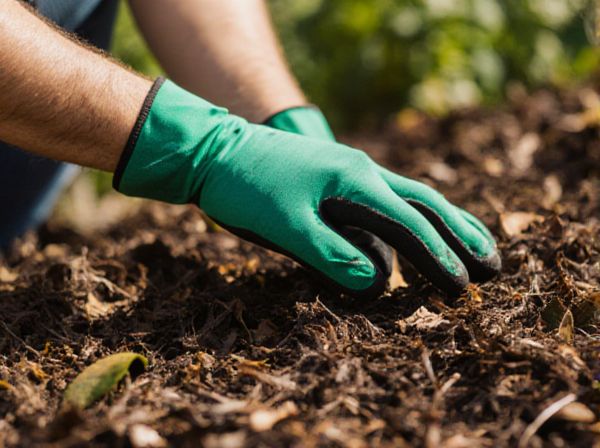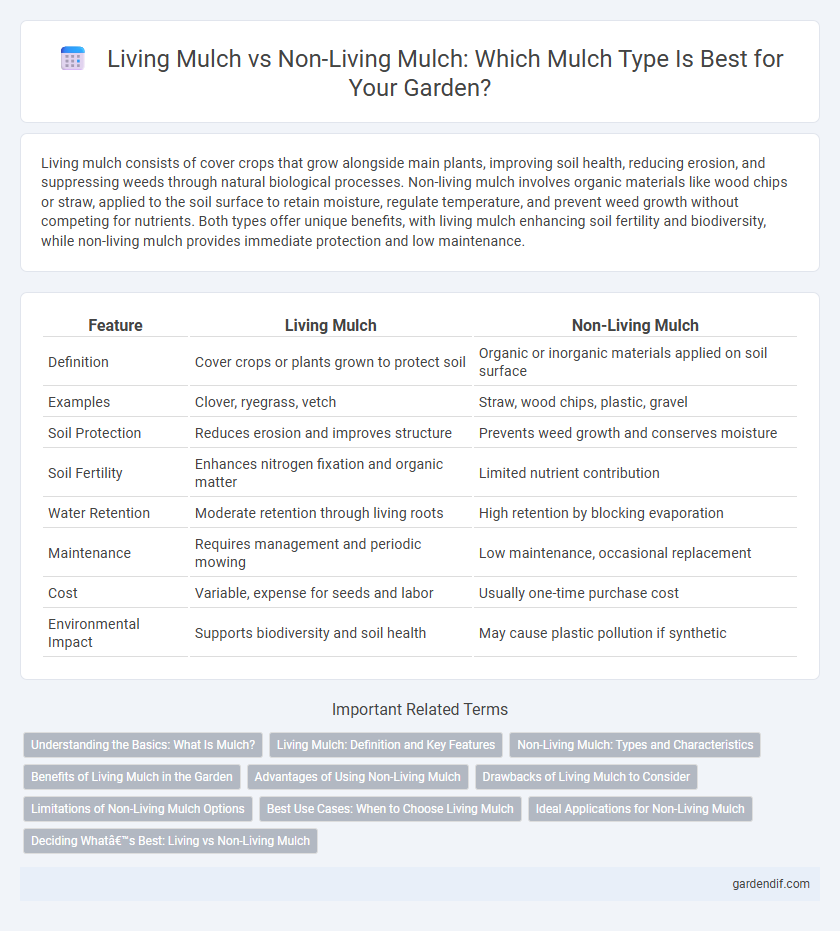
Living mulch vs non-living mulch Illustration
Living mulch consists of cover crops that grow alongside main plants, improving soil health, reducing erosion, and suppressing weeds through natural biological processes. Non-living mulch involves organic materials like wood chips or straw, applied to the soil surface to retain moisture, regulate temperature, and prevent weed growth without competing for nutrients. Both types offer unique benefits, with living mulch enhancing soil fertility and biodiversity, while non-living mulch provides immediate protection and low maintenance.
Table of Comparison
| Feature | Living Mulch | Non-Living Mulch |
|---|---|---|
| Definition | Cover crops or plants grown to protect soil | Organic or inorganic materials applied on soil surface |
| Examples | Clover, ryegrass, vetch | Straw, wood chips, plastic, gravel |
| Soil Protection | Reduces erosion and improves structure | Prevents weed growth and conserves moisture |
| Soil Fertility | Enhances nitrogen fixation and organic matter | Limited nutrient contribution |
| Water Retention | Moderate retention through living roots | High retention by blocking evaporation |
| Maintenance | Requires management and periodic mowing | Low maintenance, occasional replacement |
| Cost | Variable, expense for seeds and labor | Usually one-time purchase cost |
| Environmental Impact | Supports biodiversity and soil health | May cause plastic pollution if synthetic |
Understanding the Basics: What Is Mulch?
Living mulch consists of cover crops or ground plants grown alongside main crops to suppress weeds, improve soil health, and retain moisture through natural processes. Non-living mulch involves materials like wood chips, straw, or plastic that physically block weeds and reduce soil evaporation without contributing organic matter directly. Both types enhance plant growth, but living mulch actively enriches soil fertility while non-living mulch primarily provides physical protection.
Living Mulch: Definition and Key Features
Living mulch consists of cover crops or ground plants grown alongside main crops to protect soil and enhance fertility. Key features include nitrogen fixation, weed suppression, improved soil structure, and moisture retention, contributing to sustainable agricultural practices. Unlike non-living mulch, living mulch continuously interacts with the soil ecosystem, promoting biodiversity and long-term soil health.
Non-Living Mulch: Types and Characteristics
Non-living mulch includes materials such as plastic sheeting, rubber mulch, gravel, and wood chips, each offering unique benefits like moisture retention, weed suppression, and temperature regulation. Plastic mulch, often made of polyethylene, provides excellent weed control and soil warming but lacks organic matter contribution. Rubber and gravel mulches are durable and long-lasting but may affect soil aeration and require careful consideration regarding environmental impact.
Benefits of Living Mulch in the Garden
Living mulch enhances soil fertility by fixing nitrogen and improving organic matter, promoting healthier plant growth. It reduces soil erosion and conserves moisture more effectively than non-living mulch through continuous ground cover. Furthermore, living mulch supports biodiversity by attracting beneficial insects and microorganisms crucial for a balanced garden ecosystem.
Advantages of Using Non-Living Mulch
Non-living mulch, such as plastic sheeting or wood chips, effectively suppresses weeds and retains soil moisture, leading to healthier plant growth and reduced irrigation needs. It provides long-lasting ground cover that minimizes soil erosion and temperature fluctuations, promoting a stable root environment. Unlike living mulch, non-living mulch requires less maintenance and does not compete with crops for nutrients or water.
Drawbacks of Living Mulch to Consider
Living mulch can compete with main crops for water, nutrients, and sunlight, potentially reducing crop yields. It may also harbor pests and diseases, increasing management complexities and costs. Inadequate control of living mulch growth can lead to soil moisture depletion and create challenges during harvest.
Limitations of Non-Living Mulch Options
Non-living mulch options like plastic or landscape fabric can limit soil aeration and water infiltration, potentially harming root development. These materials often fail to decompose, reducing soil organic matter and beneficial microbial activity over time. Additionally, non-living mulches may require frequent replacement, increasing long-term maintenance costs and environmental waste.
Best Use Cases: When to Choose Living Mulch
Living mulch is ideal for sustainable agriculture and erosion control due to its ability to improve soil structure, enhance nutrient cycling, and suppress weeds naturally. It enhances biodiversity and moisture retention in perennial cropping systems or orchards where permanent ground cover is beneficial. Non-living mulch is better for annual crops or when immediate weed suppression and temperature regulation are required without long-term soil modification.
Ideal Applications for Non-Living Mulch
Non-living mulch, such as rubber, gravel, or plastic films, is ideal for pathways, driveways, and ornamental garden beds where long-lasting weed suppression and minimal maintenance are priorities. These mulches prevent soil erosion, retain moisture, and provide a clean, uniform appearance without the need for regular replenishment. Their durability makes them suitable for high-traffic areas and landscapes requiring consistent ground coverage without nutrient contribution.
Deciding What’s Best: Living vs Non-Living Mulch
Living mulch, consisting of cover crops like clover or ryegrass, enhances soil health by fixing nitrogen, improving moisture retention, and suppressing weeds through natural growth. Non-living mulch, such as wood chips, straw, or plastic films, provides immediate weed control and moisture conservation without competing for nutrients but lacks the soil enrichment benefits of living varieties. Choosing between living and non-living mulch depends on specific garden needs, soil conditions, and long-term sustainability goals.
Living mulch vs non-living mulch Infographic

 gardendif.com
gardendif.com